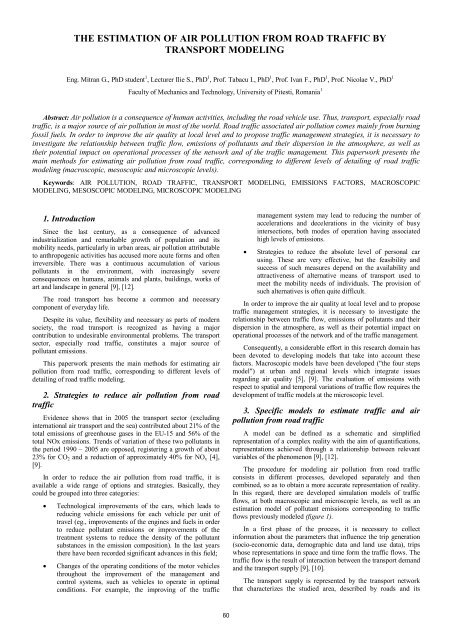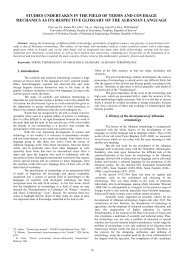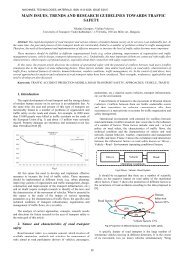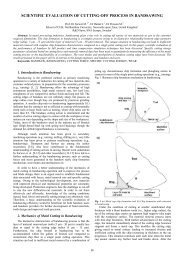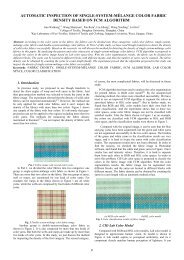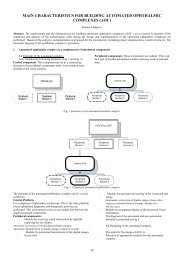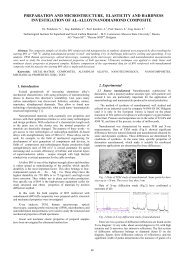the estimation of air pollution from road traffic by transport modeling
the estimation of air pollution from road traffic by transport modeling
the estimation of air pollution from road traffic by transport modeling
Create successful ePaper yourself
Turn your PDF publications into a flip-book with our unique Google optimized e-Paper software.
THE ESTIMATION OF AIR POLLUTION FROM ROAD TRAFFIC BY<br />
TRANSPORT MODELING<br />
Eng. Mitran G., PhD student 1 , Lecturer Ilie S., PhD 1 , Pr<strong>of</strong>. Tabacu I., PhD 1 , Pr<strong>of</strong>. Ivan F., PhD 1 , Pr<strong>of</strong>. Nicolae V., PhD 1<br />
Faculty <strong>of</strong> Mechanics and Technology, University <strong>of</strong> Pitesti, Romania 1<br />
Abstract: Air <strong>pollution</strong> is a consequence <strong>of</strong> human activities, including <strong>the</strong> <strong>road</strong> vehicle use. Thus, <strong>transport</strong>, especially <strong>road</strong><br />
<strong>traffic</strong>, is a major source <strong>of</strong> <strong>air</strong> <strong>pollution</strong> in most <strong>of</strong> <strong>the</strong> world. Road <strong>traffic</strong> associated <strong>air</strong> <strong>pollution</strong> comes mainly <strong>from</strong> burning<br />
fossil fuels. In order to improve <strong>the</strong> <strong>air</strong> quality at local level and to propose <strong>traffic</strong> management strategies, it is necessary to<br />
investigate <strong>the</strong> relationship between <strong>traffic</strong> flow, emissions <strong>of</strong> pollutants and <strong>the</strong>ir dispersion in <strong>the</strong> atmosphere, as well as<br />
<strong>the</strong>ir potential impact on operational processes <strong>of</strong> <strong>the</strong> network and <strong>of</strong> <strong>the</strong> <strong>traffic</strong> management. This paperwork presents <strong>the</strong><br />
main methods for estimating <strong>air</strong> <strong>pollution</strong> <strong>from</strong> <strong>road</strong> <strong>traffic</strong>, corresponding to different levels <strong>of</strong> detailing <strong>of</strong> <strong>road</strong> <strong>traffic</strong><br />
<strong>modeling</strong> (macroscopic, mesoscopic and microscopic levels).<br />
Keywords: AIR POLLUTION, ROAD TRAFFIC, TRANSPORT MODELING, EMISSIONS FACTORS, MACROSCOPIC<br />
MODELING, MESOSCOPIC MODELING, MICROSCOPIC MODELING<br />
1. Introduction<br />
Since <strong>the</strong> last century, as a consequence <strong>of</strong> advanced<br />
industrialization and remarkable growth <strong>of</strong> population and its<br />
mobility needs, particularly in urban areas, <strong>air</strong> <strong>pollution</strong> attributable<br />
to anthropogenic activities has accused more acute forms and <strong>of</strong>ten<br />
irreversible. There was a continuous accumulation <strong>of</strong> various<br />
pollutants in <strong>the</strong> environment, with increasingly severe<br />
consequences on humans, animals and plants, buildings, works <strong>of</strong><br />
art and landscape in general [9], [12].<br />
The <strong>road</strong> <strong>transport</strong> has become a common and necessary<br />
component <strong>of</strong> everyday life.<br />
Despite its value, flexibility and necessary as parts <strong>of</strong> modern<br />
society, <strong>the</strong> <strong>road</strong> <strong>transport</strong> is recognized as having a major<br />
contribution to undesirable environmental problems. The <strong>transport</strong><br />
sector, especially <strong>road</strong> <strong>traffic</strong>, constitutes a major source <strong>of</strong><br />
pollutant emissions.<br />
This paperwork presents <strong>the</strong> main methods for estimating <strong>air</strong><br />
<strong>pollution</strong> <strong>from</strong> <strong>road</strong> <strong>traffic</strong>, corresponding to different levels <strong>of</strong><br />
detailing <strong>of</strong> <strong>road</strong> <strong>traffic</strong> <strong>modeling</strong>.<br />
2. Strategies to reduce <strong>air</strong> <strong>pollution</strong> <strong>from</strong> <strong>road</strong><br />
<strong>traffic</strong><br />
Evidence shows that in 2005 <strong>the</strong> <strong>transport</strong> sector (excluding<br />
international <strong>air</strong> <strong>transport</strong> and <strong>the</strong> sea) contributed about 21% <strong>of</strong> <strong>the</strong><br />
total emissions <strong>of</strong> greenhouse gases in <strong>the</strong> EU-15 and 56% <strong>of</strong> <strong>the</strong><br />
total NOx emissions. Trends <strong>of</strong> variation <strong>of</strong> <strong>the</strong>se two pollutants in<br />
<strong>the</strong> period 1990 – 2005 are opposed, registering a growth <strong>of</strong> about<br />
23% for CO2 and a reduction <strong>of</strong> approximately 40% for NOx [4],<br />
[9].<br />
In order to reduce <strong>the</strong> <strong>air</strong> <strong>pollution</strong> <strong>from</strong> <strong>road</strong> <strong>traffic</strong>, it is<br />
available a wide range <strong>of</strong> options and strategies. Basically, <strong>the</strong>y<br />
could be grouped into three categories:<br />
Technological improvements <strong>of</strong> <strong>the</strong> cars, which leads to<br />
reducing vehicle emissions for each vehicle per unit <strong>of</strong><br />
travel (eg., improvements <strong>of</strong> <strong>the</strong> engines and fuels in order<br />
to reduce pollutant emissions or improvements <strong>of</strong> <strong>the</strong><br />
treatment systems to reduce <strong>the</strong> density <strong>of</strong> <strong>the</strong> pollutant<br />
substances in <strong>the</strong> emission composition). In <strong>the</strong> last years<br />
<strong>the</strong>re have been recorded significant advances in this field;<br />
Changes <strong>of</strong> <strong>the</strong> operating conditions <strong>of</strong> <strong>the</strong> motor vehicles<br />
throughout <strong>the</strong> improvement <strong>of</strong> <strong>the</strong> management and<br />
control systems, such as vehicles to operate in optimal<br />
conditions. For example, <strong>the</strong> improving <strong>of</strong> <strong>the</strong> <strong>traffic</strong><br />
60<br />
management system may lead to reducing <strong>the</strong> number <strong>of</strong><br />
accelerations and decelerations in <strong>the</strong> vicinity <strong>of</strong> busy<br />
intersections, both modes <strong>of</strong> operation having associated<br />
high levels <strong>of</strong> emissions.<br />
Strategies to reduce <strong>the</strong> absolute level <strong>of</strong> personal car<br />
using. These are very effective, but <strong>the</strong> feasibility and<br />
success <strong>of</strong> such measures depend on <strong>the</strong> availability and<br />
attractiveness <strong>of</strong> alternative means <strong>of</strong> <strong>transport</strong> used to<br />
meet <strong>the</strong> mobility needs <strong>of</strong> individuals. The provision <strong>of</strong><br />
such alternatives is <strong>of</strong>ten quite difficult.<br />
In order to improve <strong>the</strong> <strong>air</strong> quality at local level and to propose<br />
<strong>traffic</strong> management strategies, it is necessary to investigate <strong>the</strong><br />
relationship between <strong>traffic</strong> flow, emissions <strong>of</strong> pollutants and <strong>the</strong>ir<br />
dispersion in <strong>the</strong> atmosphere, as well as <strong>the</strong>ir potential impact on<br />
operational processes <strong>of</strong> <strong>the</strong> network and <strong>of</strong> <strong>the</strong> <strong>traffic</strong> management.<br />
Consequently, a considerable effort in this research domain has<br />
been devoted to developing models that take into account <strong>the</strong>se<br />
factors. Macroscopic models have been developed ("<strong>the</strong> four steps<br />
model") at urban and regional levels which integrate issues<br />
regarding <strong>air</strong> quality [5], [9]. The evaluation <strong>of</strong> emissions with<br />
respect to spatial and temporal variations <strong>of</strong> <strong>traffic</strong> flow requires <strong>the</strong><br />
development <strong>of</strong> <strong>traffic</strong> models at <strong>the</strong> microscopic level.<br />
3. Specific models to estimate <strong>traffic</strong> and <strong>air</strong><br />
<strong>pollution</strong> <strong>from</strong> <strong>road</strong> <strong>traffic</strong><br />
A model can be defined as a schematic and simplified<br />
representation <strong>of</strong> a complex reality with <strong>the</strong> aim <strong>of</strong> quantifications,<br />
representations achieved through a relationship between relevant<br />
variables <strong>of</strong> <strong>the</strong> phenomenon [9], [12].<br />
The procedure for <strong>modeling</strong> <strong>air</strong> <strong>pollution</strong> <strong>from</strong> <strong>road</strong> <strong>traffic</strong><br />
consists in different processes, developed separately and <strong>the</strong>n<br />
combined, so as to obtain a more accurate representation <strong>of</strong> reality.<br />
In this regard, <strong>the</strong>re are developed simulation models <strong>of</strong> <strong>traffic</strong><br />
flows, at both macroscopic and microscopic levels, as well as an<br />
<strong>estimation</strong> model <strong>of</strong> pollutant emissions corresponding to <strong>traffic</strong><br />
flows previously modeled (figure 1).<br />
In a first phase <strong>of</strong> <strong>the</strong> process, it is necessary to collect<br />
information about <strong>the</strong> parameters that influence <strong>the</strong> trip generation<br />
(socio-economic data, demographic data and land use data), trips<br />
whose representations in space and time form <strong>the</strong> <strong>traffic</strong> flows. The<br />
<strong>traffic</strong> flow is <strong>the</strong> result <strong>of</strong> interaction between <strong>the</strong> <strong>transport</strong> demand<br />
and <strong>the</strong> <strong>transport</strong> supply [9], [10].<br />
The <strong>transport</strong> supply is represented <strong>by</strong> <strong>the</strong> <strong>transport</strong> network<br />
that characterizes <strong>the</strong> studied area, described <strong>by</strong> <strong>road</strong>s and its
intersections. The formalization <strong>of</strong> <strong>the</strong> network is achieved <strong>by</strong> a<br />
planar graph with arcs and nodes, in which <strong>the</strong> <strong>road</strong>s are represented<br />
<strong>by</strong> oriented arcs and <strong>the</strong> junction points <strong>by</strong> nodes. Arcs can be<br />
linked to features such as: direction, length, <strong>traffic</strong> capacity, number<br />
<strong>of</strong> lanes with <strong>the</strong>ir width, impedance. Nodes are associated with<br />
characteristics specific to intersections, such as: <strong>traffic</strong> direction, <strong>the</strong><br />
type signaling, <strong>the</strong> <strong>traffic</strong> light cycle lasting, in <strong>the</strong> case <strong>of</strong><br />
intersections with <strong>traffic</strong> lights.<br />
The demand for <strong>transport</strong> services has a high degree <strong>of</strong> quality<br />
and differentiation [9], [10].<br />
Fig. 1 Process <strong>modeling</strong> to estimate <strong>the</strong> <strong>air</strong> <strong>pollution</strong> <strong>from</strong> <strong>road</strong> <strong>traffic</strong>.<br />
The <strong>transport</strong> demand for occupies a place in space. The<br />
spatiality <strong>of</strong> demand <strong>of</strong>ten leads to lack <strong>of</strong> coordination, resulting in<br />
a strong imbalance between <strong>transport</strong> supply and <strong>transport</strong> demand.<br />
The <strong>transport</strong> supply and demand show dynamic characteristics. A<br />
significant share <strong>of</strong> <strong>transport</strong> demand is concentrated, especially in<br />
urban areas, during <strong>traffic</strong> peak periods. This variable nature <strong>of</strong><br />
<strong>transport</strong> demand makes more difficult, but interesting at <strong>the</strong> same<br />
time, <strong>the</strong> analysis and <strong>the</strong> prediction. Each trip is <strong>the</strong> result <strong>of</strong> a<br />
series <strong>of</strong> multiple choices made <strong>by</strong> <strong>the</strong> individual. The demand is<br />
influenced <strong>by</strong> <strong>the</strong> choice <strong>of</strong> making a trip for some reason, on a<br />
certain route and within a certain time <strong>of</strong> day, when <strong>the</strong> user is<br />
dependent on <strong>the</strong> automobile, and, for those who do not have cars,<br />
this choice will contain also <strong>the</strong> stage <strong>of</strong> option for a <strong>transport</strong><br />
mode.<br />
The demand models formalize <strong>the</strong> user choices concerning:<br />
<strong>the</strong> decision <strong>of</strong> making or not <strong>the</strong> trip for some reason or<br />
purpose;<br />
travel destination;<br />
<strong>the</strong> <strong>transport</strong> mode used;<br />
<strong>the</strong> followed route in a time reference.<br />
In <strong>the</strong> case <strong>of</strong> <strong>modeling</strong> <strong>the</strong> <strong>transport</strong> demand at macroscopic<br />
level, it is expressed through origin/destination matrices (O/D)<br />
corresponding to analyzed <strong>traffic</strong> zones. In <strong>the</strong> microscopic<br />
<strong>modeling</strong>, it addresses a disaggregated treatment <strong>of</strong> input data, each<br />
vehicle being individually simulated.<br />
The aggregation level <strong>of</strong> variables depends on <strong>the</strong> purpose for<br />
which it is elaborated <strong>the</strong> model. The <strong>modeling</strong> at macroscopic level<br />
requires data aggregated at zonal level, while in microscopic<br />
<strong>modeling</strong>, more detailed information is needed, and sometimes<br />
<strong>the</strong>se data are difficult to obtain.<br />
In <strong>the</strong> macroscopic representation <strong>the</strong> <strong>traffic</strong> is associated with a<br />
compressible fluid, so that can be applied <strong>the</strong> fluid mechanics<br />
<strong>the</strong>ories. The <strong>traffic</strong> is characterized <strong>by</strong> three variables: flow<br />
61<br />
(volume), speed and density [9], [13]. Supporting this <strong>the</strong>ory is <strong>the</strong><br />
relationship between <strong>traffic</strong> flow and <strong>traffic</strong> density.<br />
The ma<strong>the</strong>matical relationship between <strong>the</strong> three parameters has<br />
<strong>the</strong> form:<br />
(1) q k v<br />
with: q = 1/h and k = 1/s,<br />
where:<br />
q [vehicles/hour] is <strong>the</strong> vehicle flow;<br />
k [vehicles /km] is <strong>the</strong> <strong>traffic</strong> density;<br />
v [km/hour] is <strong>the</strong> average speed;<br />
h [hours] is succession interval;<br />
s [km] is <strong>the</strong> distance between successive vehicles.<br />
Since in <strong>the</strong> macroscopic approach, <strong>the</strong> <strong>traffic</strong> is treated as a<br />
continuous flow, <strong>the</strong>re is not possible a detailed representation <strong>of</strong><br />
travel speed variation, associated with individual or categories <strong>of</strong><br />
motor vehicles trips, which compose <strong>the</strong> <strong>traffic</strong> flows. This issue<br />
constitutes a major limitation <strong>of</strong> <strong>the</strong> <strong>traffic</strong> <strong>modeling</strong> at macroscopic<br />
level, because <strong>the</strong> speed fluctuations shows a considerable<br />
importance in <strong>modeling</strong> <strong>air</strong> <strong>pollution</strong> <strong>from</strong> <strong>road</strong> <strong>traffic</strong>.<br />
An alternative to <strong>the</strong> macroscopic representation <strong>of</strong> <strong>traffic</strong> flows<br />
is <strong>the</strong> microscopic representation. Road <strong>traffic</strong> microsimulation<br />
models take into account <strong>the</strong> individual behavior <strong>of</strong> vehicles and are<br />
used to forecast <strong>the</strong> likely impact <strong>of</strong> changes in <strong>traffic</strong> conditions. In<br />
this situation, <strong>the</strong> <strong>traffic</strong> flow characteristics are obtained as a result<br />
<strong>of</strong> <strong>the</strong> aggregation <strong>of</strong> individual behavior <strong>of</strong> cars which compose <strong>the</strong><br />
<strong>traffic</strong> flow. The particularity <strong>of</strong> microsimulation models consists in<br />
<strong>the</strong> analysis capability <strong>of</strong> <strong>the</strong> congested <strong>transport</strong> network, due to its<br />
ability to simulate <strong>the</strong> waiting conditions. This ability gives to such<br />
type <strong>of</strong> models a great utility in <strong>the</strong> analysis <strong>of</strong> <strong>traffic</strong> operations in<br />
urban areas and city centers, including nodes, roundabouts, marked<br />
or unmarked intersections.<br />
To simulate <strong>the</strong> behavior <strong>of</strong> each motor vehicle is required, on<br />
<strong>the</strong> one hand, a large amount <strong>of</strong> input data and, on <strong>the</strong> o<strong>the</strong>r hand,<br />
advanced computer systems. Therefore, <strong>the</strong> microscopic<br />
representation <strong>of</strong> <strong>traffic</strong> flows, was until recently considered too<br />
demanding to be to practically applied in <strong>transport</strong> studies [6], [9],<br />
[11]. In recent years, <strong>the</strong>re has been made considerable progress in<br />
terms <strong>of</strong> capacity and applicability <strong>of</strong> <strong>the</strong> macroscopic <strong>traffic</strong> flow<br />
<strong>modeling</strong>, both in <strong>the</strong> urban and inter-urban areas. The<br />
microsimulation models have attracted attention through its ability<br />
to visually represent <strong>the</strong> expected <strong>traffic</strong> behavior through 3D<br />
animation. The most important s<strong>of</strong>tware packages which include<br />
<strong>the</strong>se abilities are: Vissim, Tsis-Corsim, Cube Dynasim, Lisa+,<br />
Quadstone Paramics, SiAS Paramics, Sim<strong>traffic</strong>, Aimsun.<br />
3.1. The macroscopic <strong>modeling</strong> <strong>of</strong> <strong>air</strong> <strong>pollution</strong><br />
<strong>from</strong> <strong>road</strong> <strong>traffic</strong><br />
The current approaches in <strong>the</strong> field <strong>of</strong> <strong>modeling</strong> <strong>air</strong> <strong>pollution</strong><br />
<strong>from</strong> <strong>road</strong> <strong>traffic</strong> can be classified into three categories:<br />
macroscopic, mesoscopic and microscopic.<br />
In a macroscopic model, <strong>the</strong> <strong>traffic</strong> is represented as a<br />
compressible fluid, and <strong>the</strong> movement <strong>of</strong> each vehicle cannot be<br />
monitored. Emissions are usually determined depending on total<br />
<strong>traffic</strong> volume and average speed <strong>of</strong> <strong>traffic</strong> flow. Thus, <strong>the</strong><br />
macroscopic models may not represent, in general, <strong>the</strong> influence <strong>of</strong><br />
speed fluctuations.<br />
In Europe, it has been developed since 1982 a macroscopic<br />
model for estimating emissions <strong>from</strong> <strong>road</strong> <strong>traffic</strong> in <strong>the</strong> Transport<br />
Research Laboratory (TRL) in Great Britain. The model defines CO<br />
emissions as a direct function <strong>of</strong> average <strong>traffic</strong> speed and flow and<br />
<strong>the</strong>n express <strong>the</strong> emissions <strong>of</strong> o<strong>the</strong>r pollutants (eg, HC, NOx and Pb)<br />
depending <strong>by</strong> <strong>the</strong> volume <strong>of</strong> CO emissions.
The empirical relationship between speed, flow and CO<br />
emission is:<br />
(2)<br />
where:<br />
E(<br />
CO ) 1,<br />
031<br />
q v<br />
( CO ) g / m<br />
0,<br />
795<br />
10<br />
4<br />
E is <strong>the</strong> volume <strong>of</strong> CO emissions;<br />
vehicles / hour <br />
q is <strong>the</strong> trafic flow;<br />
km / hour <br />
v is <strong>the</strong> average speed.<br />
The environmental Protection Agencies <strong>from</strong> Germany,<br />
Switzerland and Austria (HBEFA) have developed a model for<br />
determining <strong>the</strong> pollutant emission associated to <strong>the</strong> emissions<br />
factors NOx, CO, HC and SO2 <strong>from</strong> individual <strong>transport</strong>, which is<br />
using as input data <strong>the</strong> emissions volumes specific for each <strong>of</strong> <strong>the</strong>se<br />
factors (figure 2). Each emission factor has an associated regression<br />
curve with <strong>the</strong> form:<br />
The volume <strong>of</strong> CO emissions [g/km]<br />
(3)<br />
where:<br />
20<br />
18<br />
16<br />
14<br />
12<br />
10<br />
8<br />
0<br />
4<br />
2<br />
2 3 4 5<br />
Emiss a b v c v d v e v f v<br />
[g/m]<br />
v is <strong>the</strong> velocity recorded on each arc <strong>from</strong> <strong>the</strong> analyzed<br />
network, <strong>by</strong> categories <strong>of</strong> vehicles;<br />
a , b,<br />
c,<br />
d , e,<br />
f are regression coefficients specific to each<br />
pollutant, both for cars and for trucks, having as reference<br />
<strong>the</strong> years 1990, 1992 and 2000.<br />
0<br />
0<br />
10<br />
HGV (same values for all years)<br />
20<br />
Passenger cars 1990<br />
30<br />
Passenger cars 1992<br />
40<br />
50<br />
60<br />
Speed [km/h]<br />
70<br />
Passenger cars 2000<br />
Fig. 2 The <strong>estimation</strong> <strong>of</strong> <strong>the</strong> emissions volume – CO [9], [14].<br />
80 90 100 110<br />
Both described above macroscopic models for calculating<br />
emissions <strong>from</strong> <strong>road</strong> <strong>traffic</strong>, provide quick and relatively simple<br />
instruments <strong>of</strong> assessing <strong>the</strong> impact <strong>of</strong> <strong>road</strong> <strong>traffic</strong> on <strong>air</strong> <strong>pollution</strong>,<br />
but <strong>the</strong>se have disadvantages regarding <strong>the</strong> quantification <strong>of</strong> <strong>the</strong><br />
impact determined <strong>by</strong> <strong>the</strong> changes in vehicles speed.<br />
3.2 The <strong>modeling</strong> <strong>of</strong> <strong>air</strong> <strong>pollution</strong> <strong>from</strong> <strong>road</strong> <strong>traffic</strong><br />
at mesoscopic-level<br />
Beside <strong>the</strong> macroscopic approach, <strong>the</strong> <strong>modeling</strong> at mesoscopic<br />
level has as objective <strong>the</strong> determination <strong>of</strong> <strong>the</strong> influence <strong>of</strong> speed<br />
variations. This is possible <strong>by</strong> estimating <strong>the</strong> volume <strong>of</strong> emissions<br />
depending on driving style, characterized <strong>by</strong> a number <strong>of</strong> different<br />
modes <strong>of</strong> using <strong>the</strong> motor vehicle (acceleration, deceleration, cruise<br />
and queueing), each <strong>of</strong> <strong>the</strong>se generating different levels <strong>of</strong><br />
emissions.<br />
A typical example <strong>of</strong> mesoscopic approach in this area is <strong>the</strong><br />
model developed <strong>by</strong> Matzoros and Van Vliet [8], realized using <strong>the</strong><br />
s<strong>of</strong>tware package Saturn. This model can estimate <strong>the</strong> emissions<br />
values for four different usage modes (acceleration, deceleration,<br />
cruise and queueing) in <strong>the</strong> vicinity <strong>of</strong> an intersection.<br />
62<br />
In figure 3 are represented <strong>the</strong> four operating regimes imposed<br />
<strong>by</strong> <strong>the</strong> car driver signaled intersections. The duration associated<br />
with each operating system can be calculated <strong>by</strong> applying <strong>the</strong><br />
waiting string <strong>the</strong>ory. The four operating modes <strong>of</strong> <strong>the</strong> motor<br />
vehicles are characterized <strong>by</strong> constant speed during <strong>the</strong> cruise mode,<br />
constant variation <strong>of</strong> <strong>the</strong> speed during acceleration and deceleration<br />
regimes, and zero speed during idle operation mode.<br />
Distance<br />
Cruise<br />
Queueing<br />
Deceleration<br />
Acceleration<br />
Cruise<br />
Fig. 3 The using regimes <strong>of</strong> <strong>the</strong> motor vehicle in an intersection [8], [9].<br />
Time<br />
The advantage is that <strong>the</strong> mesoscopic model can highlight<br />
different operating conditions <strong>of</strong> <strong>the</strong> flow <strong>of</strong> <strong>traffic</strong> along a section<br />
<strong>of</strong> <strong>road</strong> and near intersections through macroscopic representation<br />
<strong>of</strong> <strong>traffic</strong> flow. The mesoscopic models do not require additional<br />
input data compared with macroscopic models, but only values <strong>of</strong><br />
standard emissions specific to each operation regime.<br />
The deficiency <strong>of</strong> this model consists in its inability to describe<br />
<strong>the</strong> influence <strong>of</strong> speed variation <strong>of</strong> motor vehicles on <strong>air</strong> <strong>pollution</strong>.<br />
3.3 The <strong>modeling</strong> at <strong>the</strong> microscopic level <strong>of</strong> <strong>air</strong><br />
<strong>pollution</strong> <strong>from</strong> <strong>road</strong> <strong>traffic</strong><br />
The microscopic models quantify <strong>the</strong> emissions at <strong>the</strong> level <strong>of</strong><br />
each vehicle in <strong>the</strong> structure <strong>of</strong> <strong>traffic</strong> flow, being taken into account<br />
<strong>the</strong> parameters that characterize <strong>the</strong> movement <strong>of</strong> <strong>the</strong> vehicle, such<br />
as: instantaneous speed, acceleration, motorization category. The<br />
total emissions associated with <strong>traffic</strong> flow are obtained <strong>by</strong><br />
aggregating <strong>the</strong> specific emissions for each motor vehicle.<br />
Since 1974, such a model was developed <strong>by</strong> <strong>the</strong> U.S.<br />
Environmental Protection Agency [7], [9]. The volumes emissions<br />
<strong>of</strong> carbon monoxide (CO), hydrocarbons (HC) and nitrogen oxides<br />
(NOx) were deduced <strong>from</strong> tests performed on a sample <strong>of</strong> 170<br />
vehicles in six U.S. cities. This way, it was possible to investigate<br />
<strong>the</strong> variation <strong>of</strong> motor vehicle emissions in <strong>the</strong> vicinity <strong>of</strong><br />
intersections with <strong>traffic</strong> lights [1], [2], [9].<br />
In recent years, growth in computing power has enabled more<br />
and more practical use <strong>of</strong> <strong>traffic</strong> microsimulation models. The<br />
structure <strong>of</strong> such a model is presented in figure 4.<br />
There are given <strong>the</strong> necessary input data and processes that take<br />
place during microsimulation. There are used data about network<br />
configuration, signal systems, volume and structure <strong>of</strong> <strong>traffic</strong> flows,<br />
as well as characteristic data <strong>of</strong> <strong>the</strong> vehicles which form <strong>the</strong> <strong>traffic</strong><br />
flows. Following <strong>the</strong> microsimulation, it is obtained <strong>the</strong><br />
instantaneous speed and acceleration <strong>of</strong> each analyzed vehicle. This<br />
information is used in <strong>the</strong> calculation model <strong>of</strong> emission, resulting<br />
<strong>the</strong> concentration for each emission factor in <strong>the</strong> analyzed area.
Vehicle fleet<br />
information<br />
Network<br />
Signal<br />
Wind speed<br />
and direction<br />
Traffic volume<br />
Simulation model<br />
<strong>of</strong> <strong>traffic</strong> flow at<br />
<strong>the</strong> microscopic level<br />
Time, instant speed, acceleration,<br />
position <strong>of</strong> each vehicle<br />
THE MODEL FOR<br />
EMISSIONS CALCULATION<br />
Concentration <strong>of</strong> pollutants<br />
at each receptor<br />
Vehicle's<br />
characteristics<br />
Emissions inventory at<br />
<strong>the</strong> microscopic level<br />
Receptor<br />
position<br />
Fig. 4 The structure <strong>of</strong> <strong>the</strong> microscopic model for estimating pollutant<br />
emissions <strong>from</strong> <strong>road</strong> <strong>traffic</strong>.<br />
4. Conclusions<br />
Air <strong>pollution</strong> is a consequence <strong>of</strong> human activities, including<br />
<strong>road</strong> vehicle use. Thus, <strong>transport</strong>, especially <strong>road</strong> <strong>traffic</strong>, is a major<br />
source <strong>of</strong> <strong>air</strong> <strong>pollution</strong> in most <strong>of</strong> <strong>the</strong> world. Road <strong>traffic</strong> associated<br />
<strong>air</strong> <strong>pollution</strong> comes mainly <strong>from</strong> burning fossil fuels.<br />
The general process <strong>of</strong> <strong>modeling</strong> <strong>air</strong> <strong>pollution</strong> generated <strong>by</strong> <strong>road</strong><br />
<strong>traffic</strong> consists <strong>of</strong> <strong>the</strong> following steps: (i) collecting data and<br />
information underlying <strong>the</strong> trips generation, (ii) estimating <strong>the</strong><br />
<strong>transport</strong> demand and <strong>the</strong> affecting <strong>of</strong> <strong>the</strong> <strong>traffic</strong> flows on <strong>the</strong> entire<br />
analyzed network and (iii) <strong>the</strong> inventory <strong>of</strong> <strong>the</strong> emissions <strong>from</strong> <strong>road</strong><br />
vehicles which compose <strong>the</strong> <strong>traffic</strong> flows.<br />
In <strong>the</strong> research in <strong>the</strong> field <strong>of</strong> <strong>transport</strong>, <strong>traffic</strong> flow<br />
representation was a key issue in <strong>modeling</strong> <strong>of</strong> <strong>air</strong> <strong>pollution</strong> <strong>from</strong><br />
<strong>road</strong> <strong>traffic</strong>. Currently, <strong>the</strong> most used models to represent <strong>traffic</strong><br />
flow are macroscopic models, which may show <strong>the</strong> average travel<br />
speed along a stretch <strong>of</strong> <strong>road</strong>. The data required in macroscopic<br />
<strong>modeling</strong> are moderate and can be easily applied to evaluate a wide<br />
range <strong>of</strong> <strong>transport</strong> strategies. But <strong>the</strong>se models are not able to reveal<br />
<strong>the</strong> local variations concerning <strong>air</strong> <strong>pollution</strong> in <strong>the</strong> vicinity <strong>of</strong><br />
intersections or in different <strong>traffic</strong> conditions. To overcome this<br />
shortcoming, mesoscopic models have been developed. Although<br />
<strong>the</strong>se are essentially based on a macroscopic representation <strong>of</strong><br />
<strong>traffic</strong> flows, <strong>the</strong>y can describe different modes <strong>of</strong> using vehicles<br />
such as acceleration, deceleration, cruising and queueing. As a<br />
result, <strong>the</strong> mesoscopic models may be useful in <strong>modeling</strong> <strong>air</strong><br />
<strong>pollution</strong> in <strong>the</strong> intersections area <strong>of</strong> influence. Therefore, special<br />
attention in <strong>the</strong> <strong>modeling</strong> <strong>of</strong> <strong>air</strong> <strong>pollution</strong> generated <strong>by</strong> <strong>road</strong> <strong>traffic</strong> is<br />
dedicated to developing models that are able to detail <strong>the</strong> <strong>traffic</strong><br />
flow characteristics, namely <strong>the</strong> microsimulation models. These<br />
models have <strong>the</strong> ability to characterize <strong>the</strong> movement <strong>of</strong> each<br />
vehicle in terms <strong>of</strong> developed instant speed and acceleration. The<br />
emissions associated with <strong>traffic</strong> flow are obtained <strong>by</strong> aggregating<br />
<strong>the</strong> specific vehicle emissions at <strong>the</strong> individual level.<br />
5. References<br />
1. Cohen, S., Use <strong>of</strong> <strong>traffic</strong> simulation in analysis <strong>of</strong> carbon<br />
monoxide <strong>pollution</strong>, Transport Research Record 648, Transportation<br />
Research Board, Washington DC., United States, 1977.<br />
2. Cohen, S., Euler, G., Signal cycle length and fuel<br />
consumption and emissions, Transportation Research Record 667,<br />
Transportation Research Board, Washington DC., United States,<br />
1978.<br />
63<br />
3. Datculescu, O., The evaluation <strong>of</strong> emission factors and <strong>traffic</strong><br />
measurements in <strong>the</strong> central area <strong>of</strong> <strong>the</strong> Bucharest Municipality,<br />
Romanian Auto Register, Bucharest, 2011.<br />
4. European Environment Agency (EEA), Emission Inventory<br />
Guidebook – Road Transport, European Environment Agency,<br />
2009.<br />
5. Hassounah, M.I., Miller, J., Modelling <strong>air</strong> <strong>pollution</strong> <strong>from</strong><br />
<strong>road</strong> <strong>traffic</strong>: a review, Traffic Engineering and Control, 1994.<br />
6. Horowitz, J., Air quality analysis for urban <strong>transport</strong>ation<br />
planning, MIT Press (Cambridge, Mass.), ISBN 0262081164, 1982.<br />
7. Kunselman, P., McAdams, H.T., Domke, M.E., Williams,<br />
M.E., Automobile exhaust emissions modal analysis model, Calspan<br />
Corporation, Buffalo, NY, Environmental Protection Agency,<br />
document No. 460/3-74-005, Office <strong>of</strong> Mobile Source Air Pollution<br />
Control, USA, 1974.<br />
8. Matzoros, A., Vliet, D., A model <strong>of</strong> <strong>air</strong> <strong>pollution</strong> <strong>from</strong> <strong>road</strong><br />
<strong>traffic</strong>, based on <strong>the</strong> characteristics <strong>of</strong> interrupted flow and junction<br />
control Part I & II, Transportation Research - A, 26 A (4), pp. 315<br />
~ 355, 1992.<br />
9. Mitran, G., The identification <strong>of</strong> major factors <strong>from</strong> <strong>road</strong><br />
<strong>traffic</strong> which produce <strong>the</strong> <strong>air</strong> <strong>pollution</strong> and <strong>the</strong> presentation <strong>of</strong> <strong>the</strong><br />
current stage <strong>of</strong> <strong>the</strong> research in <strong>road</strong> <strong>traffic</strong> <strong>modeling</strong> and <strong>air</strong><br />
<strong>pollution</strong> <strong>from</strong> <strong>road</strong> vehicles, PhD Scientific Report No. 1,<br />
University <strong>of</strong> Pitești, Romania, 2011.<br />
10. Ortuzar, J. de Dios, Willumsen, L., Modelling <strong>transport</strong>, 3 rd<br />
edition, John Wiley & Sons, London, 2001.<br />
11. Park, J. Y., Noland, R., Polak, J., Microscopic model <strong>of</strong> <strong>air</strong><br />
pollutant concentrations: comparison <strong>of</strong> simulated results with<br />
measured and macroscopic estimates, Transportation Research<br />
Record: Journal <strong>of</strong> <strong>the</strong> Transportation Research Board,<br />
Transportation Research Board <strong>of</strong> <strong>the</strong> National Academies, ISSN<br />
0361-1981, 2007.<br />
12. Popa, M., Elements <strong>of</strong> <strong>transport</strong> economics, Bren Publishing<br />
House, Bucharest, 2004.<br />
13. Taylor, M., Young T., Developing a set <strong>of</strong> fuel consumption<br />
and emissions models for use in <strong>traffic</strong> network modelling, 13 th<br />
International Symposium on Transportation and Traffic <strong>the</strong>ory,<br />
Lyon, France, 1996.<br />
14. United States Environmental Protection Agency (USEPA),<br />
Update <strong>of</strong> ambient water quality criteria for ammonia, Las Vegas,<br />
USA, 2000.<br />
Acknowledgment<br />
The preparation <strong>of</strong> Gabriela Mitran’s PhD program is funded <strong>by</strong><br />
grant doctorates <strong>from</strong> <strong>the</strong> Structural Funds <strong>of</strong> <strong>the</strong> financing contract<br />
AMPOSDRU: “Development <strong>of</strong> doctoral schools <strong>by</strong> providing<br />
scholarships for young PhD students” – ID 52826.


